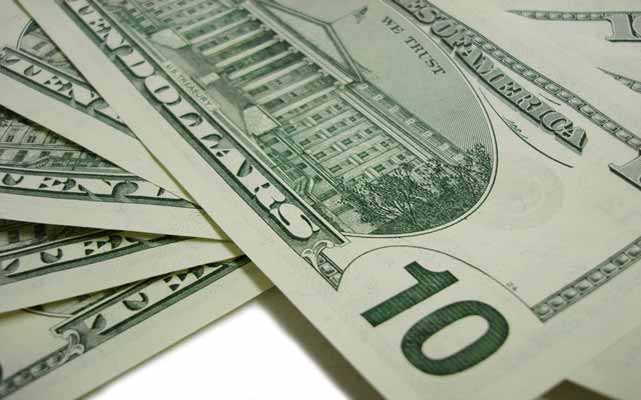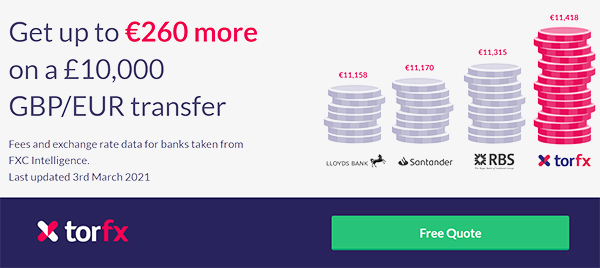Pound to Dollar Forecast: Banks Radically Hike 12-month Predictions to 1.30-1.39
April 13, 2025 - Written by Frank Davies

The Pound-to-Dollar exchange rate (GBP/USD) posted sharp losses to near 1.2700 early in the week before a surge to highs near 1.3150 as the dollar slumped amid very high volatility.
According to ING; “The question of a potential dollar confidence crisis has now been definitively answered – we are experiencing one in full force.”
Goldman Sachs has radically changed its view and is now forecasting dollar losses. The 12-month GBP/USD forecast has been revised to 1.39 from 1.24 previously.
Investment banks have generally downgraded dollar forecasts which has increased GBP/USD projections even though banks are far from convinced over the UK outlook.
According to Scotiabank, on a near-term view, gains above 1.32 would lead to gains to 1.34.
Nordea now expects GBP/USD will trade at 1.30 at the end of 2025 compared with the 1.23 forecast previously.
According to Nordea; “We have made a complete reversal in our dollar outlook and now expect the dollar to weaken rather than strengthen.”

UK GDP data was stronger than expected, but global developments dominated.
Although a slide in risk appetite undermined the Pound on the crosses, dollar losses triggered the GBP/USD rebound.
RBC pointed to huge elements of uncertainty; “The question for FX though is how the US shock will compare to the rest of the world? How much if anything will be in place a month from now, or six months from now?”
It added; “All we can say at the moment is that whether or not tariffs are implemented, the uncertainty is going to have a negative growth impact, not just on the US.”
RBC also commented; “Trump’s desire to break with the post-WW2 world order has investors questioning whether USD can retain its status as the world’s primary reserve currency.”
It added; “Summing it up leaves us with a bias for USD to drift lower over the next 12-18 months but mindful that sudden policy changes could shift that view materially in either direction.”
RBC expects GBP/USD to be capped around 1.30 over the next 12 months.

Goldman Sachs explained its change of stance; “First, the combination of an unnecessary trade war and other uncertainty-raising policies is severely eroding consumer and business confidence. Second, negative trends in US governance and institutions are eroding the appeal of US assets for foreign investors. Third, rudimentary calculations and a constant back-and-forth makes it difficult for investors to price outcomes other than high uncertainty.”
President Trump’s imposition of reciprocal tariffs had triggered an element of defensive dollar buying, but buyers were quickly overwhelmed by sellers.
Support collapsed amid fear over the US economy as the US-China trade war intensified.
After warning against retaliation, Trump increased tariffs on imports from China to 145% while China refused to back down and increased tariffs on US imports to 125%.
If these tariffs are sustained for any significant period, there will be major dislocation to trade and economic damage.
Other reciprocal tariffs were delayed by 90 days as the Administration was forced to blink amid market chaos, but uncertainty remained intense.
Unusually, US equities, bonds and the dollar all weakened at the same time which suggested a notable loss of confidence in US assets.
UBS commented; “As a result of this tariff chaos, Treasury markets saw fluctuations during the week, which reminded some investors of the “Truss-moment” from the gilt market in 2022.
UBS added; “In our view, much damage has been done, which is not easily reversible.
It forecasts GBP/USD gains to 1.34 by March 2026.
Danske Bank now forecasts GBP/USD gains to 1.41 on a 12-month view from 1.31 previously.
Scotiabank’s Chief FX Strategist Shaun Osborne also referenced UK parallels; “Financial markets can have a disciplining effect, as former UK PM Truss discovered in 2022 when the pound, Gilts and UK equities were falling in unison. That has been happening in the US this week and it is a clear signal that markets anticipate negative consequences from the US’ pursuit of aggressive tariffs on its trade partners and are dumping US assets as a result.”
He added; “The 90-day reprieve won’t help. It just prolongs the uncertainty and increases the risk of a negative economic outcome. A tariff off-ramp must be found quickly or the USD will continue to fall.”
According to ANZ group chief economist Richard Yetsenga; "Regardless of how the next 90 days evolve, the U.S.'s international reputation has been eroded."
Comments from Nomura strategist Naka Matsuzawa were unusually forthright; "I'm deeply concerned about a lack of confidence among investors in the U.S. now. It's a no confidence vote from not just the equity market but also Treasury market participants in the Trump administration and its policies."
Latest US inflation data was weaker than expected and markets expect three Fed rate cuts this year despite fears that tariffs will put upward pressure on inflation.
US Congress pushed ahead with tax cuts in the budget resolution with the budget expected to increase long-term deficits.
ING added; “We also cannot exclude that the budget resolution passed by the House yesterday, which poses significant funding questions for tax cut extensions, is adding another layer of risk premium to risk assets and Treasuries.”
Long-time dollar bull HSBC is wavering; “We have pushed back against such concerns over the years given resilient US growth supporting high yields and solid foreign demand for US assets. Yet, we cannot easily brush aside the USD’s structural weaknesses, especially given the current climate.”
STORY LINK Pound to Dollar Forecast: Banks Radically Hike 12-month Predictions to 1.30-1.39

The Pound-to-Dollar exchange rate (GBP/USD) posted sharp losses to near 1.2700 early in the week before a surge to highs near 1.3150 as the dollar slumped amid very high volatility.
According to ING; “The question of a potential dollar confidence crisis has now been definitively answered – we are experiencing one in full force.”
Goldman Sachs has radically changed its view and is now forecasting dollar losses. The 12-month GBP/USD forecast has been revised to 1.39 from 1.24 previously.
Investment banks have generally downgraded dollar forecasts which has increased GBP/USD projections even though banks are far from convinced over the UK outlook.
According to Scotiabank, on a near-term view, gains above 1.32 would lead to gains to 1.34.
Nordea now expects GBP/USD will trade at 1.30 at the end of 2025 compared with the 1.23 forecast previously.
According to Nordea; “We have made a complete reversal in our dollar outlook and now expect the dollar to weaken rather than strengthen.”

UK GDP data was stronger than expected, but global developments dominated.
Although a slide in risk appetite undermined the Pound on the crosses, dollar losses triggered the GBP/USD rebound.
RBC pointed to huge elements of uncertainty; “The question for FX though is how the US shock will compare to the rest of the world? How much if anything will be in place a month from now, or six months from now?”
It added; “All we can say at the moment is that whether or not tariffs are implemented, the uncertainty is going to have a negative growth impact, not just on the US.”
RBC also commented; “Trump’s desire to break with the post-WW2 world order has investors questioning whether USD can retain its status as the world’s primary reserve currency.”
It added; “Summing it up leaves us with a bias for USD to drift lower over the next 12-18 months but mindful that sudden policy changes could shift that view materially in either direction.”
RBC expects GBP/USD to be capped around 1.30 over the next 12 months.

Goldman Sachs explained its change of stance; “First, the combination of an unnecessary trade war and other uncertainty-raising policies is severely eroding consumer and business confidence. Second, negative trends in US governance and institutions are eroding the appeal of US assets for foreign investors. Third, rudimentary calculations and a constant back-and-forth makes it difficult for investors to price outcomes other than high uncertainty.”
President Trump’s imposition of reciprocal tariffs had triggered an element of defensive dollar buying, but buyers were quickly overwhelmed by sellers.
Support collapsed amid fear over the US economy as the US-China trade war intensified.
After warning against retaliation, Trump increased tariffs on imports from China to 145% while China refused to back down and increased tariffs on US imports to 125%.
If these tariffs are sustained for any significant period, there will be major dislocation to trade and economic damage.
Other reciprocal tariffs were delayed by 90 days as the Administration was forced to blink amid market chaos, but uncertainty remained intense.
Unusually, US equities, bonds and the dollar all weakened at the same time which suggested a notable loss of confidence in US assets.
UBS commented; “As a result of this tariff chaos, Treasury markets saw fluctuations during the week, which reminded some investors of the “Truss-moment” from the gilt market in 2022.
UBS added; “In our view, much damage has been done, which is not easily reversible.
It forecasts GBP/USD gains to 1.34 by March 2026.
Danske Bank now forecasts GBP/USD gains to 1.41 on a 12-month view from 1.31 previously.
Scotiabank’s Chief FX Strategist Shaun Osborne also referenced UK parallels; “Financial markets can have a disciplining effect, as former UK PM Truss discovered in 2022 when the pound, Gilts and UK equities were falling in unison. That has been happening in the US this week and it is a clear signal that markets anticipate negative consequences from the US’ pursuit of aggressive tariffs on its trade partners and are dumping US assets as a result.”
He added; “The 90-day reprieve won’t help. It just prolongs the uncertainty and increases the risk of a negative economic outcome. A tariff off-ramp must be found quickly or the USD will continue to fall.”
According to ANZ group chief economist Richard Yetsenga; "Regardless of how the next 90 days evolve, the U.S.'s international reputation has been eroded."
Comments from Nomura strategist Naka Matsuzawa were unusually forthright; "I'm deeply concerned about a lack of confidence among investors in the U.S. now. It's a no confidence vote from not just the equity market but also Treasury market participants in the Trump administration and its policies."
Latest US inflation data was weaker than expected and markets expect three Fed rate cuts this year despite fears that tariffs will put upward pressure on inflation.
US Congress pushed ahead with tax cuts in the budget resolution with the budget expected to increase long-term deficits.
ING added; “We also cannot exclude that the budget resolution passed by the House yesterday, which poses significant funding questions for tax cut extensions, is adding another layer of risk premium to risk assets and Treasuries.”
Long-time dollar bull HSBC is wavering; “We have pushed back against such concerns over the years given resilient US growth supporting high yields and solid foreign demand for US assets. Yet, we cannot easily brush aside the USD’s structural weaknesses, especially given the current climate.”
International Money Transfer? Ask our resident FX expert a money transfer question or try John's new, free, no-obligation personal service! ,where he helps every step of the way, ensuring you get the best exchange rates on your currency requirements.
Comments are currrently disabled
Related Stories:
- Pound to Euro Forecast: GBP Bounces, Buy vs EUR Below 1.1450 say ING - April 14, 2025
- Euro to Dollar Forecasts HIKED to 1.20 at MUFG Over Twelve Month Timeline - April 14, 2025
- Pound to Euro Week Ahead Forecast: Short-Term Buy, 1.19 by Q3 2025 - April 13, 2025
- Pound to Dollar Forecast: Banks Radically Hike 12-month Predictions to 1.30-1.39 - April 13, 2025
- Pound to Euro Forecast: Buy Dips to 1.1430, March 2026 Target 1.1765 say UBS - April 11, 2025
- Euro to Dollar Forecast RAISED to 1.14 in 12 Months at Danske Bank - April 10, 2025
- Pound to Dollar Forecast: Sterling Buyers Takes Advantage of Risk Recovery - April 10, 2025
- Euro to Pound Forecasts RAISED to 0.86 in Six Months at Rabobank - April 9, 2025
- Pound Sterling Forecast: GBP Recovers vs EUR USD, Next US-China Moves Crucial - April 8, 2025
Latest News:
- Pound Recovers Against Euro and Dollar as Sterling Outperforms G10 Currencies - April 15, 2025
- Tariff Panic Subsides, Pound Gains vs Euro, Dollar on Foreign Exchange Markets - April 14, 2025
- Pound to Euro Forecast: GBP Bounces, Buy vs EUR Below 1.1450 say ING - April 14, 2025
- Euro "Remains in Overbought Territory" say Credit Agricole - April 14, 2025
- Pound-to-Euro Rate Rises Despite Advancing EUR/USD Amid Tariff Chaos - April 14, 2025
- GBP/USD Forecast: Pound Gains on Soft Dollar and Risk Relief, Close to 1.32 - April 14, 2025
- Euro to Dollar Forecasts HIKED to 1.20 at MUFG Over Twelve Month Timeline - April 14, 2025
- Pound to Euro Week Ahead Forecast: Short-Term Buy, 1.19 by Q3 2025 - April 13, 2025
- Pound to Dollar Forecast: Banks Radically Hike 12-month Predictions to 1.30-1.39 - April 13, 2025
- Pound-to-Euro Rate Recovers as Dollar Battered on Bond Sell-off - April 12, 2025








